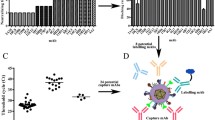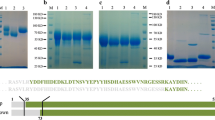Summary
The level of humoral and cell mediated immunity in persons with low or undetectable hemagglutination-inhibition (HAI) rubella titers was investigated by ELISA, IgG presence in sucrose gradient separated serum fractions and lymphocyte transformation. The study population consisted of persons with stated history of natural rubella infection and rubella vaccinees. Persons with natural rubella infection and HAI titers of 1:8 or ±1:8 (i.e., incomplete HAI at serum dilution of 1:8) were all ELISA positive and the stimulation index (SI) of specific lymphocyte transformation was higher than 2.5. Among the 20 persons with HAI titers of <1:8, 8 were found to be ELISA positive and their SI was also >2 and IgG was detected in their serum. Rubella vaccinees with HAI titers of 1:8 or ±1:8 were likewise ELISA positive. Their SI was lower: none higher than 3, but none lower than 1.5. Among 23 HAI negative vaccinees, 14 were found ELISA positive. This serum fraction contained IgG and the SI was >1.5. It appears that ELISA test is able to detect antibodies where the HAI test fails. The positive outcome of ELISA test in this case was confirmed by the presence of IgG in serum fractions and by the lymphocyte response to rubella specific stimulation.
Similar content being viewed by others
References
Balfour, H. H., Balfour, C. L., Edelman, C. K., Rierson, P. A.: Evaluation of Wistar RA27/3 rubella virus vaccine in children. Amer. J. Dis. Child.130, 1089–1091 (1976).
Buimovici-Klein, E., Vesikari, T., Santangelo, C. F., Cooper, L. Z.: Study of the lymphocytein vitro response to rubella antigen and PHA by a whole blood method. Arch. Virol.52, 323–331 (1976).
Buimovici-Klein, E., Weiss, K. E., Cooper, L. Z.: Interferon production in lymphocyte cultures after rubella infection in humans. J. inf. Dis.135, 380–385 (1977).
Chang, T., Weinstein, L.: Studies of nonspecific inhibition of the hemagglutinin of rubella virus and isolation and identification of the inhibitor. Amer. J. med. Sciences263, 233–239 (1972).
Doherty, N., Ronalds, C. J., Pattison, J. R., Heath, R. B.: A comparative study of methods used for removing nonspecific inhibitors of rubella hemagglutination from human sera. Med. Lab. Technology32, 317–320 (1975).
Engwall, E., Johnsson, K., Perlmann, P.: Enzyme-linked immunosorbent assay II. Quantitative assay of protein antigen, immunoglobulin G, by means of an enzyme-labeled anti-immunoglobulin in antigen-coated tubes. J. Immunol.19, 129–135 (1971).
Engwall, E., Perimann, P.: Enzyme-linked immunosorbent assay, ELISA III. Quantitation of specific antibodies by enzyme-labeled anti-immunoglobulin in antigen-coated tubes. J. Immunol.109, 129–135 (1972).
Farguhar, J. D.: Follow-up on rubella vaccinations and experience with subclinical infection. J. Pediatrics81, 460–465 (1972).
Fogel, A., Gerichter, C. B., Barnea, B., Handsher, R., Heeger, E.: Response to experimental challenge in persons immunized with different rubella vaccines. J. Pediatrics92, 26–29 (1978).
Forghani, B., Schmidt, N. J.: Antigen requirements, sensitivity and specificity of enzyme immunoassays for measles and rubella viral antibodies. J. clin. Microbiol.9, 657–664 (1979).
Gravell, M., Dorsett, P. H., Gutenson, O., Ley, A. C.: Detection of antibody to rubella virus by enzyme-linked immunosorbent assay. J. inf. Dis.136, 5300 to 5303 (1977).
Honeyman, M. C., Forrest, J. M., Dorman, D. C.: Cell-mediated immune response following natural rubella and rubella vaccination. Clin. exp. Immunol.17, 665–671 (1974).
MacDonald, H., O'H. Tobin, J., Cradock-Watson, J. E., Lomax, J.: Antibody titres in women six to eight years after the administration of RA 27/3 and Cendehill rubella vaccines. J. Hyg. (Camb.)80, 337–347 (1978).
Negro Ponzi, A., Pugliese, A., Pertusio, P.: Rubella virus hemagglutination with human and animal erythrocytes: Effect of age and trypsinization. J. clin. Microbiol.7, 442–447 (1978).
Rauh, J. L., Schiff, G. M., Johnson, L. B.: Follow-up studies of rubella vaccinees at adolescence. J. Pediatrics86, 138–140 (1975).
Rossier, E., Phipps, H. P., Polley, J. R., Webb, T.: Absence of cell-mediated immunity to rubella virus 5 years after rubella vaccination. CMA Journal116, 481–483 (1977).
Schiff, G. M., Rauh, J. L., Rotte, T., Trimble, S.: Two-year follow-up of rubella vaccinees in a public school system. Amer. J. Dis. Child.123, 193–196 (1972).
Smith, J. A., Cummins, A. C.: Evaluation of a rubella hemagglutination inhibition test system. J. clin. Microbiol3, 5–7 (1975)
Vestergaard, B. F., Grauballe, P. C.: ELISA for HSV type-specific antibodies in human sera using HSV type 1 and type 2 polyspecific antigens blocked with type-heterologous rabbit antibodies. Acta path. microbiol. scand. Sect. B78, 261–263 (1979).
Author information
Authors and Affiliations
Additional information
With 1 Figure
Rights and permissions
About this article
Cite this article
Buimovici-Klein, E., O'Beirne, A.J., Millian, S.J. et al. Low level rubella immunity detected by ELISA and specific lymphocyte transformation. Archives of Virology 66, 321–327 (1980). https://doi.org/10.1007/BF01320628
Received:
Accepted:
Issue Date:
DOI: https://doi.org/10.1007/BF01320628




